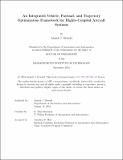An Integrated Vehicle, Payload, and Trajectory Optimization Framework for Highly-Coupled Aircraft Systems
Author(s)
Dewald, Annick J.
DownloadThesis PDF (31.51Mb)
Advisor
Hansman, R. John
Terms of use
Metadata
Show full item recordAbstract
A class of highly-coupled aircraft systems is identified in Earth observation applications, where the aircraft design couples tightly with the science instrument design and the operation of both the aircraft and science payload. This dissertation identifies an opportunity to simultaneously optimize the aircraft platform, the science payload, and the operational strategy under one system-level objective function to improve the performance of the total aircraft system. This approach extends the field of MDO which demonstrates that simultaneously optimizing all the subsystems within a larger system allows the optimizer to leverage the couplings between disciplines, rather than be subject to them, resulting in better performance outcomes [1]. The inclusion of the instrument and trajectory into the optimization problem introduces additional objectives related to the science mission needs. While many methods for multi-objective optimization exist in the field, these methods are not tractable with the many objectives within these complex systems. A methodology is proposed to explore trade-offs between multiple objectives by sweeping through different combinations of weighting terms in a weighted-sum objective function to find Pareto optimal design points across the design space. These design points are then evaluated within the objective space, a hyperspace where each axis corresponds to a different objective, to understand the performance capabilities with respect to each objective and evaluate trade-offs between objectives. Findings from this objective space exploration can then be communicated to the science stakeholder to find the design that is best capable of meeting the identified science mission needs. This dissertation then applies this methodology to a series of case studies on a representative science mission. The science mission objective of these case studies is to reduce uncertainty in predictions of sea-level rise by understanding ice mechanics that drive ice shelf collapse and destabilize previously grounded glaciers.
Date issued
2024-09Department
Massachusetts Institute of Technology. Department of Aeronautics and AstronauticsPublisher
Massachusetts Institute of Technology